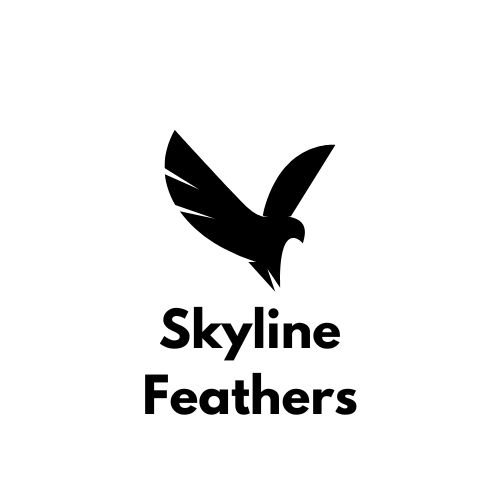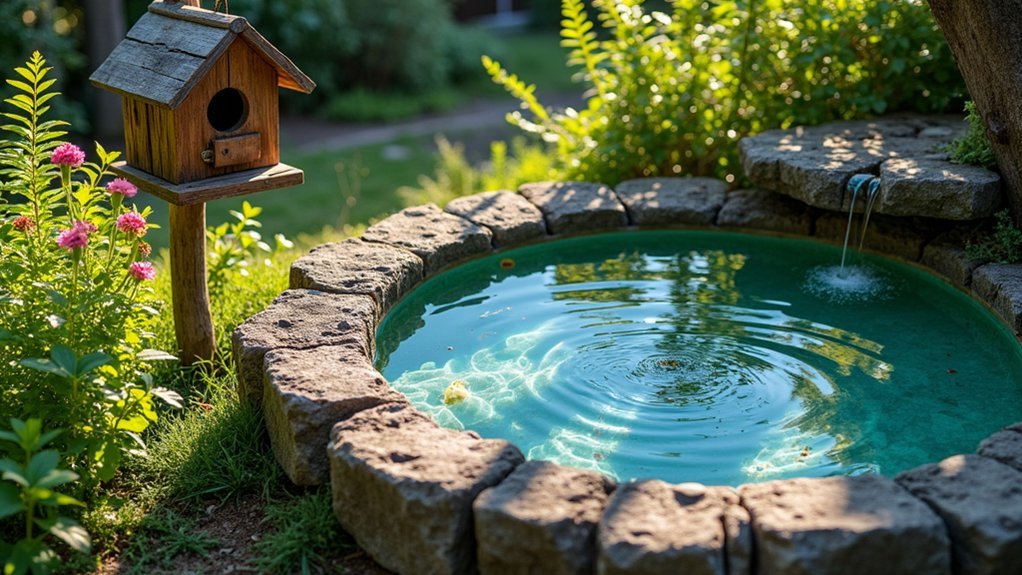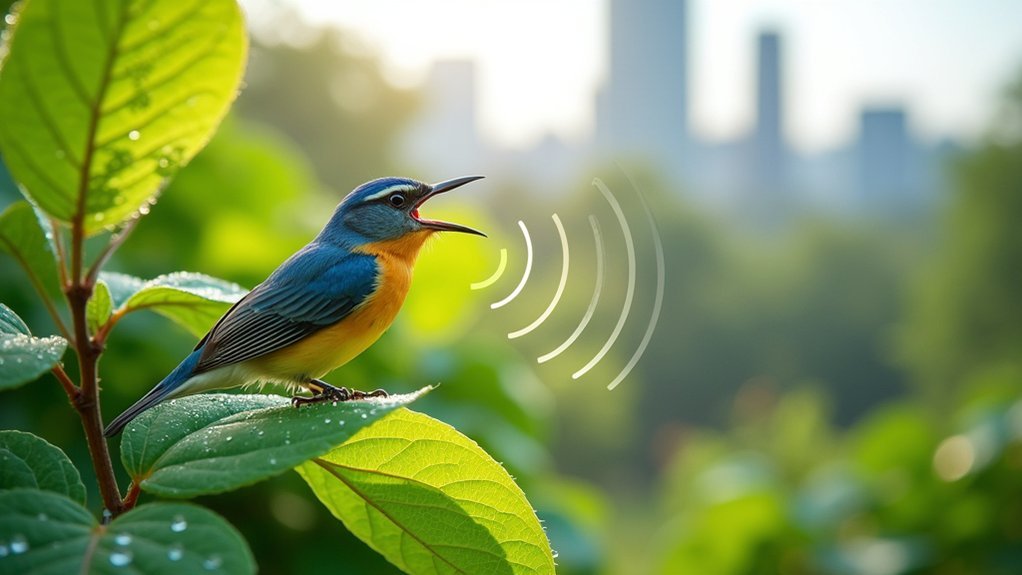Creating perfect backyard bath spots for city wildlife is simple and rewarding. Place shallow clay dishes (5-10cm deep) in quiet, partially shaded areas with gentle slopes for safe access. Add rocks or twigs to help smaller creatures climb in and out. Keep water fresh by changing it every 2-4 days and clean weekly with diluted vinegar. Surrounding your bath with native plants offers additional shelter and food sources, transforming your urban space into a thriving wildlife haven.
Perfect Backyard Bath Spots for City Wildlife

While urban environments often lack natural water sources, creating your own backyard bath spots can be a lifeline for city wildlife.
You’ll attract wildlife by placing shallow clay dishes filled with sand and water in shady areas near native plants for protection. These retreats should be 30-50 cm wide and 5-10 cm deep for easy access.
Bird baths are particularly effective, drawing numerous feathered visitors to your urban yard. For a more substantial option, install a small pond or solar-powered fountain, which provides both hydration and visual appeal.
Remember to maintain clean water by changing it regularly and monitoring quality.
Strategic placement near plants that provide food creates a complete habitat. Your thoughtful water features will transform your city space into a thriving wildlife sanctuary.
Essential Elements of Urban Wildlife Water Features
Your wildlife-friendly water feature needs gentle slopes and shallow depths to guarantee all creatures can safely access it without falling in.
You don’t need a huge yard to make a difference—a simple ceramic dish on a balcony or small patio can attract numerous species.
Incorporating these accessibility features in compact designs allows even apartment dwellers to create valuable hydration stations for urban wildlife.
Accessibility Matters Most
What good is a backyard water feature if local wildlife can’t safely use it? When you provide water for urban wildlife, depth is critical—keep it shallow, no deeper than three inches. This accessibility guarantees small birds and insects can safely drink without drowning risks.
| Feature | Why It Matters | Best Practices |
|---|---|---|
| Depth | Prevents drowning | Maximum 3 inches deep |
| Location | Safety from predators | Shady, open areas |
| Surface | Provides grip | Rough materials like concrete |
| Maintenance | Prevents disease | Change water every 2-4 days |
Place your bird bath in a shady yet open spot where creatures can approach without fear. Choose containers with rough surfaces for better footing. Remember that regular maintenance is vital—fresh water every few days keeps your wildlife visitors healthy and returning to your thoughtfully designed oasis.
Space-Saving Setup Ideas
Even the smallest urban spaces can host wildlife-friendly water features with thoughtful planning.
Consider shallow drinking holes using clay dishes 30-50 cm wide and 5-10 cm deep—they’re perfect for tiny urban gardens while attracting diverse visitors. Surround these bird baths with native plants like heucheras for vital cover.
For ultra-compact spaces, try DIY water features using inverted pot lids placed at ground level.
Butterfly puddlers—small containers filled with sand and water—require minimal space while providing essential hydration for pollinators. Small water sources less than three inches deep guarantee accessibility for birds and mammals alike.
If you have slightly more room, create a simple pond with shallow edges and aquatic plants.
This water for wildlife option maximizes biodiversity value in your urban garden while maintaining a modest footprint.
Selecting the Ideal Location for Bird Baths in Concrete Spaces

When placing your bird bath in a concrete space, you’ll need to balance visibility with protection by positioning it where birds can spot approaching threats while having quick access to nearby shrubs or branches.
Your bath should be partially shaded to keep water temperatures comfortable and reduce algae growth, yet open enough that birds feel safe from lurking predators.
Create distinct splash zones by varying the water depth or adding stones, giving birds of different sizes options for drinking and bathing while maintaining a clear sightline to their surroundings.
Visibility vs. Predator Protection
Finding the perfect location for your concrete bird bath requires carefully balancing two competing needs: visibility and protection. Birds need clear sightlines to spot approaching predators, yet also require nearby cover for quick escape.
Place your bath where birds have good visibility of the surroundings, but within a short flight to shrubs or low branches for safety. Opt for shaded spots that keep water cooler while reducing algae growth.
For ground-level baths, choose open areas that provide easy access while maintaining clear escape routes. Remember to monitor for neighborhood cats or hawks when selecting your location.
Keep the bath shallow—three inches or less—to accommodate various species without drowning risk. Avoid positioning beneath feeders where droppings might contaminate the water your feathered visitors rely on.
Shade and Splash Zones
Three essential factors determine the ideal placement of concrete bird baths: shade, safety, and accessibility. Position your water feature in shaded areas to keep water cooler and prevent algae growth—especially important where concrete surfaces heat up quickly.
| Feature | Benefit | Best Practice | Wildlife Impact |
|---|---|---|---|
| Shade | Cooler water | Under trees/eaves | Attracts more species |
| Ground level | Accessibility | 3″ or less depth | Supports smaller birds |
| Rough texture | Safety | Choose concrete/terra-cotta | Prevents slipping |
| Splash zones | Options | Add pot saucers with pebbles | Serves diverse needs |
Install your bird bath near shrubs or low branches where birds can safely observe before approaching. Create additional splash zones with small-sized dishes to accommodate different native wildlife. Fresh water accessibility transforms your concrete space into a haven for urban visitors.
Creating Shallow Puddles for Butterflies and Bees
Everyone knows about bird baths, but our smaller garden visitors need refreshment too.
While birds enjoy deeper water features, bees and butterflies require shallow puddles where they won’t drown.
To create these perfect insect drinking spots, fill a flat dish with damp sand and water.
Place small stones or pebbles to serve as landing pads, providing cover for timid visitors.
Position your small pond in sunny areas where butterflies can warm themselves while hydrating.
Surround your puddle with native flowers and plants to attract bees and other pollinators.
Remember to refresh the water regularly to prevent stagnation and mosquito breeding.
Meeting the water needs of these tiny creatures is simple yet rewarding – you’ll soon notice increased pollinator activity transforming your garden into a thriving ecosystem.
Designing Multi-Level Water Sources for Diverse Species

While a simple bird bath meets basic needs, creating multi-level water features transforms your backyard into a wildlife haven that serves creatures of all sizes.
Design tiered bird baths or cascading ponds with varying depths that accommodate everything from tiny songbirds to larger mammals.
A thoughtfully tiered water feature welcomes all wildlife—from delicate finches to thirsty deer—creating an inclusive sanctuary in your garden.
Incorporate shallow shelves along the edges of your water sources where smaller creatures like frogs and insects can safely drink. Use textured materials like rough stone to prevent animals from slipping as they navigate between levels.
Your multi-level ponds will create humidity-rich micro-environments that attract moisture-loving species.
Don’t forget to surround your water features with native plants that provide additional food and shelter.
This strategic placement enhances biodiversity, creating a complete ecosystem where wildlife can access water, food, and protection all in one thoughtfully designed space.
Maintenance Strategies for Clean, Safe Wildlife Baths
Keeping your wildlife baths clean isn’t just about aesthetics—it’s vital for the health of your backyard visitors. Change the water every two to four days, or daily during extreme temperatures, to prevent mosquito larvae from developing.
Weekly cleaning is important to maintain a healthy environment. Scrub baths with a diluted vinegar solution to remove algae, then rinse thoroughly. For everyday cleaning, mild soap works well.
Don’t forget to add rocks or twigs as perches to help pollinators and smaller birds safely access the water without drowning.
Regularly monitor how wildlife interacts with your baths to verify they’re actually being used. You might need to adjust placement or features to better attract birds and other creatures.
These simple maintenance habits will keep your wildlife baths safe and inviting.
Incorporating Native Plants Around Water Features

To truly transform your wildlife bath into a thriving ecosystem, native plants deserve a prime spot in your design strategy. These plants create biodiversity hotspots by providing both food sources and habitat for local wildlife while requiring minimal maintenance due to their adaptation to local conditions.
| Native Plant | Wildlife Benefit |
|---|---|
| Cup Plant | Collects water, attracts birds |
| Cardinal Flower | Feeds hummingbirds, purifies water |
| Flowering Shrubs | Provides protective cover |
| Native Grasses | Creates nesting material |
| Milkweed | Supports monarch butterflies |
Year-Round Considerations for Urban Wildlife Hydration
Urban wildlife faces significant hydration challenges throughout the seasons as natural water sources become increasingly scarce in developed areas.
As cities expand, wildlife struggles to find water, a critical resource vanishing from our concrete landscapes.
You’ll need to add water consistently, changing it every two to four days to prevent disease spread, and daily during heat waves.
A simple pond or butterfly puddler provides an accessible source of water for native birds and small mammals year-round.
Place rocks or twigs in smaller containers so insects can safely drink without drowning.
For winter months, consider a heated bird bath when temperatures drop below freezing.
While a larger water feature like a small pond offers greater biodiversity benefits, even modest options make a vital difference.
Remember that your backyard water source might be the only reliable hydration option for countless urban creatures during seasonal extremes.
Frequently Asked Questions
How to Attract Wildlife to Your Backyard?
You’ll attract wildlife by providing food through native plants and bird feeders, water in shallow baths, and shelter with brush piles. Don’t forget to add mason bee houses for essential pollinators.
Is It Okay to Put Water Out for Wild Animals?
Yes, it’s okay to put water out for wild animals. You should change it every 2-4 days, use shallow containers, and avoid chemicals. This helps prevent dehydration and supports wildlife health in your area.
How Do I Build a Wildlife Sanctuary in My Backyard?
You’ll need to plant native species for food and shelter, add diverse water sources, build nesting sites, avoid chemicals, and maintain regularly. These elements create a thriving sanctuary that supports local wildlife and biodiversity.
Where Is the Best Place to Put Water for Birds?
Place your bird bath in a shady, open area near shrubs that offer escape routes. Keep it away from feeders, maintain shallow water levels, and you’ll attract birds while keeping them safe.
In Summary
You’ve now got everything you need to create beautiful bath spots that’ll transform your urban space into a wildlife haven. Remember, you’re providing more than water—you’re offering sanctuary. Keep your baths clean, surrounded by native plants, and accessible year-round. With these simple additions to your city oasis, you’ll soon welcome a diverse community of grateful winged and furry neighbors.





Leave a Reply